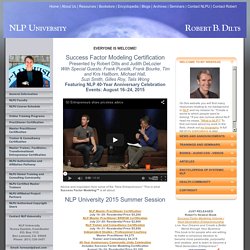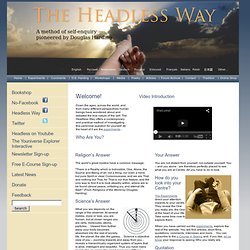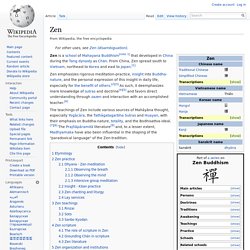

The NLP Center of New York: Neuro-Linguistic Programming and Hypnosis. Transformational grammar. In linguistics, a transformational grammar or transformational-generative grammar (TGG) is a generative grammar, especially of a natural language, that has been developed in the syntactic structures of phrase structure grammars (as opposed to dependency grammars).

Transformational grammar is the tradition of specific transformational grammars. Much current research in transformational grammar is inspired by Chomsky's Minimalist Program.[1] Deep structure and surface structure[edit] EANLPt - European Association for Neuro-Linguistic Psychotherapy. Map–territory relation. "The map is not the territory"[edit] The expression "the map is not the territory" first appeared in print in a paper that Alfred Korzybski gave at a meeting of the American Association for the Advancement of Science in New Orleans, Louisiana in 1931:[1] In Science and Sanity, Korzybski acknowledges his debt to mathematician Eric Temple Bell, whose epigram "the map is not the thing mapped" was published in Numerology.[2] A) A map may have a structure similar or dissimilar to the structure of the territory...B) A map is not the territory.

Korzybski's dictum "the map is not the territory" is also cited as an underlying principle used in neuro-linguistic programming, where it is used to signify that individual people in fact do not in general have access to absolute knowledge of reality, but in fact only have access to a set of beliefs they have built up over time, about reality. NLPU.com. Advice and inspiration from some of the "New Entrepreneurs.

" This is what Success Factor Modeling™ is all about. NLP Master Practitioner Certification July 16–29: Residential Price $5,200NLP Master Practitioner BRIDGE Certification July 23–29: Residential Price $2,800NLP Trainer and Consultancy Certification July 16–31: Residential Price $5,850Independent Studies / Professional Courtesy Master Practitioner $4,275 Trainer and Consultancy $4,37540-Year Anniversary Community Unity Celebration Includes Success Factor Modeling Certification August 16–24: Residential Price $3,100 All classes are open for enrollment.
Contact Teresa Epstein at teresanlp@aol.com or (831) 336-3457 to reserve your place. For Information in Spanish about any NLPU program please contact Susana Dominguez. August 16–24: Residential Price $3,100 Included in Community Unity Celebration Program The focus of this 9-day workshop is on applying Success Factor Modeling™ to become an effective "entrepreneur. " REGISTER TODAY! The Headless Way. Religion’s Answer The world’s great mystics have a common message: "There is a Reality which is Indivisible, One, Alone, the Source and Being of all; not a thing, nor even a mind, but pure Spirit or clear Consciousness; and we are That and nothing but That, for That is our true Nature; and the only way to find It is to look steadily within, where are to be found utmost peace, unfading joy, and eternal life itself.

" Buddhism and NLP - John David Hoag, NLP Training, Coaching & Therapy. The Zen Of Steve Jobs: A Closer Look. Guifeng Zongmi. Guifeng Zongmi (圭峰 宗密) (Wade-Giles: Kuei-feng Tsung-mi; Japanese: Keihō Shūmitsu) (780–841) was a Tang dynasty Buddhist scholar-monk, installed as fifth patriarch of the Huayan (Chinese: 華嚴; pinyin: Huáyán; Japanese: Kegon; Sanskrit: Avatamsaka) school as well as a patriarch of the Heze (WG: Ho-tse) lineage of Southern Chan. Zongmi was deeply affected by both Chan and Huayan.
He wrote a number of works on the contemporary situation of Buddhism in Tang China, including critical analyses of Chan and Huayan, as well as numerous scriptural exegeses. Zongmi was deeply interested in both the practical and doctrinal aspects of Buddhism. He was especially concerned about harmonizing the views of those that tended toward exclusivity in either direction. He provided doctrinal classifications of the Buddhist teachings, accounting for the apparent disparities in the Buddhist doctrines by categorizing them according to their specific aims. Jinul. Bojo Jinul (Hangul: 보조지눌; hanja: 普照知訥, 1158–1210), often called Jinul or Chinul for short, was a Korean monk of the Goryeo period, who is considered to be the most influential figure in the formation of Korean Seon (Zen) Buddhism.
He is credited as the founder of the Jogye Order, by working to unify the disparate sects in Korean Buddhism into a cohesive organization. Biography[edit] Bojo Jinul's birthname was Jeong and by age 15 he left his family to ordain under Seon Master Jonghwi of Sagulsan Mountain School, one of the Nine Mountain Schools of Korean Seon, receiving the ordination name "Jinul". This occurred in 1173. By 1182, Jinul passed the royal examination for monks and qualified for a higher administrative position, but turned it down to join the Seon community in Pyongyang's Bojesa Temple. This earned him the respect of the Goryeo Dynasty, and in particular King Huijong who ordered that Mount Songgwangsan be renamed to Jogyesan in his honor.
Zen. Zen is a school of Mahayana Buddhism[note 1] that developed in China during the Tang dynasty as Chán.

From China, Zen spread south to Vietnam, northeast to Korea and east to Japan. Zen emphasizes rigorous meditation-practice, insight into Buddha-nature, and the personal expression of this insight in daily life, especially for the benefit of others. As such, it deemphasizes mere knowledge of sutras and doctrine and favors direct understanding through zazen and interaction with an accomplished teacher. The teachings of Zen include various sources of Mahāyāna thought, especially Yogācāra, the Tathāgatagarbha Sutras and Huayan, with their emphasis on Buddha-nature, totality, and the Bodhisattva-ideal. Shaolin Kung Fu. Shaolin Kung Fu refers to a collection of Chinese martial arts that claim affiliation with the Shaolin Monastery.

Internal and external arts[edit] Huang Zongxi described martial arts in terms of Shaolin or "external" arts versus Wudang or internal arts in 1669.[1] It has been since then that Shaolin has been popularly synonymous for what are considered the external Chinese martial arts, regardless of whether or not the particular style in question has any connection to the Shaolin Monastery. Some say that there is no differentiation between the so-called internal and external systems of the Chinese martial arts,[2][3] while other well-known teachers have expressed differing opinions.
For example, the Taijiquan teacher Wu Jianquan: Those who practice Shaolinquan leap about with strength and force; people not proficient at this kind of training soon lose their breath and are exhausted. Origin[edit] Legend of Bodhidharma[edit] According to the Yì Jīn Jīng, History[edit] Chinese monks. Lucid-code - Hacking human consciousness in search of focused awareness and peak performance.